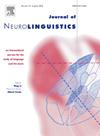从运动到言语:内侧额叶皮层沿尾侧到吻侧预测误差梯度的动作监测
IF 1.2
3区 心理学
Q2 LINGUISTICS
引用次数: 0
摘要
语音错误监测利用了人脑的内侧额叶皮层(MFC)区域。MFC中与错误监测相关的活动已经被解释为冲突监测和反馈驱动控制,但由于MFC的类似区域涉及从基本运动控制到高级认知控制功能的不同水平的行为控制,因此需要更全面的解释。此外,由于语音错误和其他涉及不同控制需求的行为涉及广泛但部分重叠的MFC区域,这种解释应该理想地解释MFC中与错误相关的功能激活的解剖分布。在这里,我们想要评估MFC在评估运动和心理行为的行为结果方面具有类似作用的假设,它沿着高-低程度的认知控制需求的喙端-尾端梯度运行,包括来自感觉和认知来源的预测错误。为此,我们对MFC区域的显性言语错误监测(即涉及最大程度的认知控制需求,研究I和II)、舌头运动监测(即涉及中等程度的认知控制需求)和舌头运动(即涉及最低程度的认知控制需求,研究II)相关的任务- fmri BOLD激活峰进行了个体特异性注释。结果显示,在MFC的三个对比中存在重叠的簇,但重要的是,峰的数量及其沿吻侧尾轴的相对位置与MFC中吻侧尾轴的分层加工梯度一致。虽然舌运动在MFC显示更多的尾侧激活,但明显言语错误监测显示更多的吻侧激活,舌运动监测在两者之间。此外,两项研究的综合结果表明,具有副扣带回的参与者的激活峰位于更背侧,复制了先前记录的运动效应,并进一步支持MFC在非常不同的动作中的共同功能作用。本文章由计算机程序翻译,如有差异,请以英文原文为准。
From movements to words: action monitoring in the medial frontal cortex along a caudal to rostral prediction error gradient
Speech error monitoring recruits the medial frontal cortex (MFC) region in the human brain. Error monitoring-related activity in the MFC has been interpreted both in terms of conflict monitoring and feedback-driven control, but as similar regions of the MFC are implicated in various levels of behavioral control ranging from basic motor movement control to high-level cognitive control functions, a more comprehensive account is needed. Moreover, as speech errors and other actions that involve varying control demands engage a widespread yet partially overlapping set of regions of the MFC, such an account should ideally explain the anatomical distribution of error-related functional activations within the MFC. Here we wanted to assess the hypothesis that the MFC has a similar role in the evaluation of action outcomes for motor and mental actions, operating along a rostral-caudal gradient of higher-lower degree of cognitive control demands involving prediction errors from both sensory and epistemic sources. To this end, we conducted an individual-specific annotation of task-fMRI BOLD activation peaks related to overt speech error monitoring (i.e. that involve the largest degree of cognitive control demands, Study I and II), tongue movement monitoring (i.e. that involve an intermediate degree of cognitive control demands) and tongue movement (i.e. that involve the lowest degree of cognitive control demands, Study II) in the MFC region. Results revealed overlapping clusters across the three contrasts across the MFC, but importantly both the number of peaks and their relative position along the rostral caudal axis were consistent with a hierarchical rostral caudal processing gradient in the MFC. While tongue movement showed more caudal activation in the MFC, overt speech error monitoring showed more rostral activation, and tongue movement monitoring patterned in between. Furthermore, the combined results of both studies suggested that activation peaks were located more dorsally for participants that had a paracingulate gyrus, replicating a previously documented effect for movement and further supporting a common functional role of the MFC across very distinct actions.
求助全文
通过发布文献求助,成功后即可免费获取论文全文。
去求助
来源期刊

Journal of Neurolinguistics
医学-神经科学
CiteScore
3.90
自引率
5.00%
发文量
49
审稿时长
17.2 weeks
期刊介绍:
The Journal of Neurolinguistics is an international forum for the integration of the neurosciences and language sciences. JNL provides for rapid publication of novel, peer-reviewed research into the interaction between language, communication and brain processes. The focus is on rigorous studies of an empirical or theoretical nature and which make an original contribution to our knowledge about the involvement of the nervous system in communication and its breakdowns. Contributions from neurology, communication disorders, linguistics, neuropsychology and cognitive science in general are welcome. Published articles will typically address issues relating some aspect of language or speech function to its neurological substrates with clear theoretical import. Interdisciplinary work on any aspect of the biological foundations of language and its disorders resulting from brain damage is encouraged. Studies of normal subjects, with clear reference to brain functions, are appropriate. Group-studies on well defined samples and case studies with well documented lesion or nervous system dysfunction are acceptable. The journal is open to empirical reports and review articles. Special issues on aspects of the relation between language and the structure and function of the nervous system are also welcome.
 求助内容:
求助内容: 应助结果提醒方式:
应助结果提醒方式:


